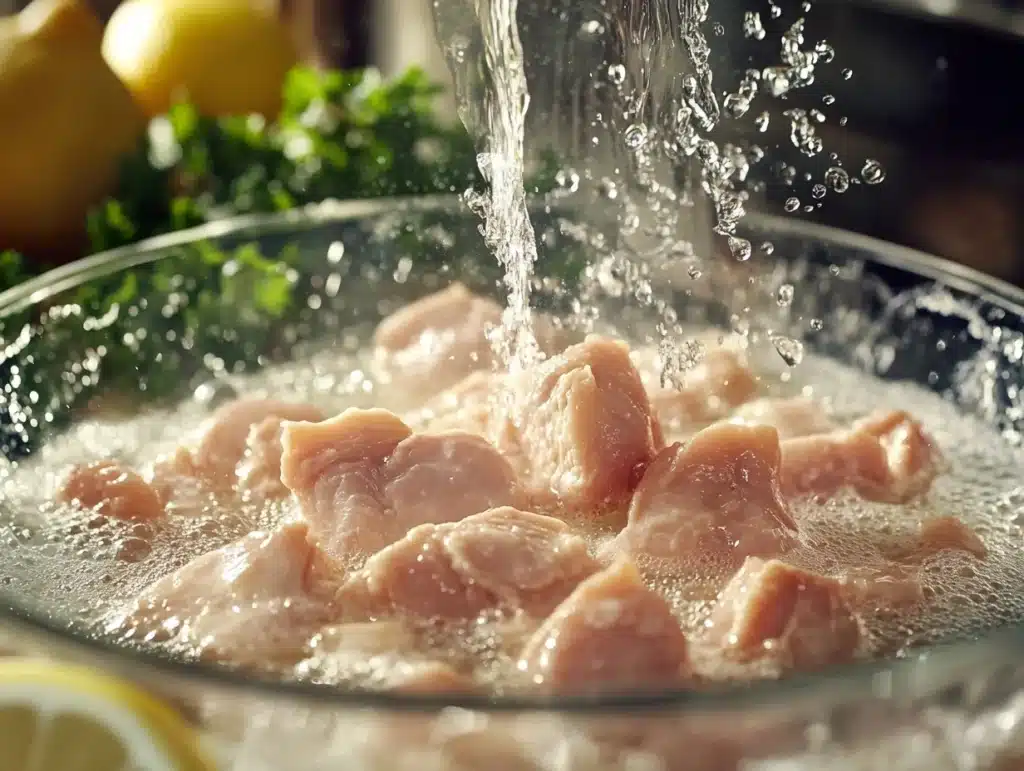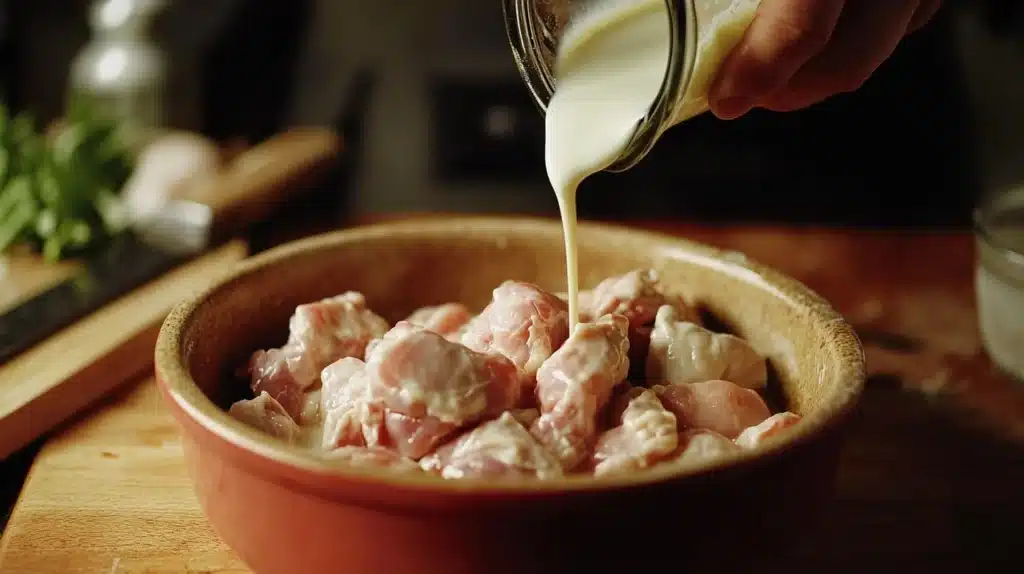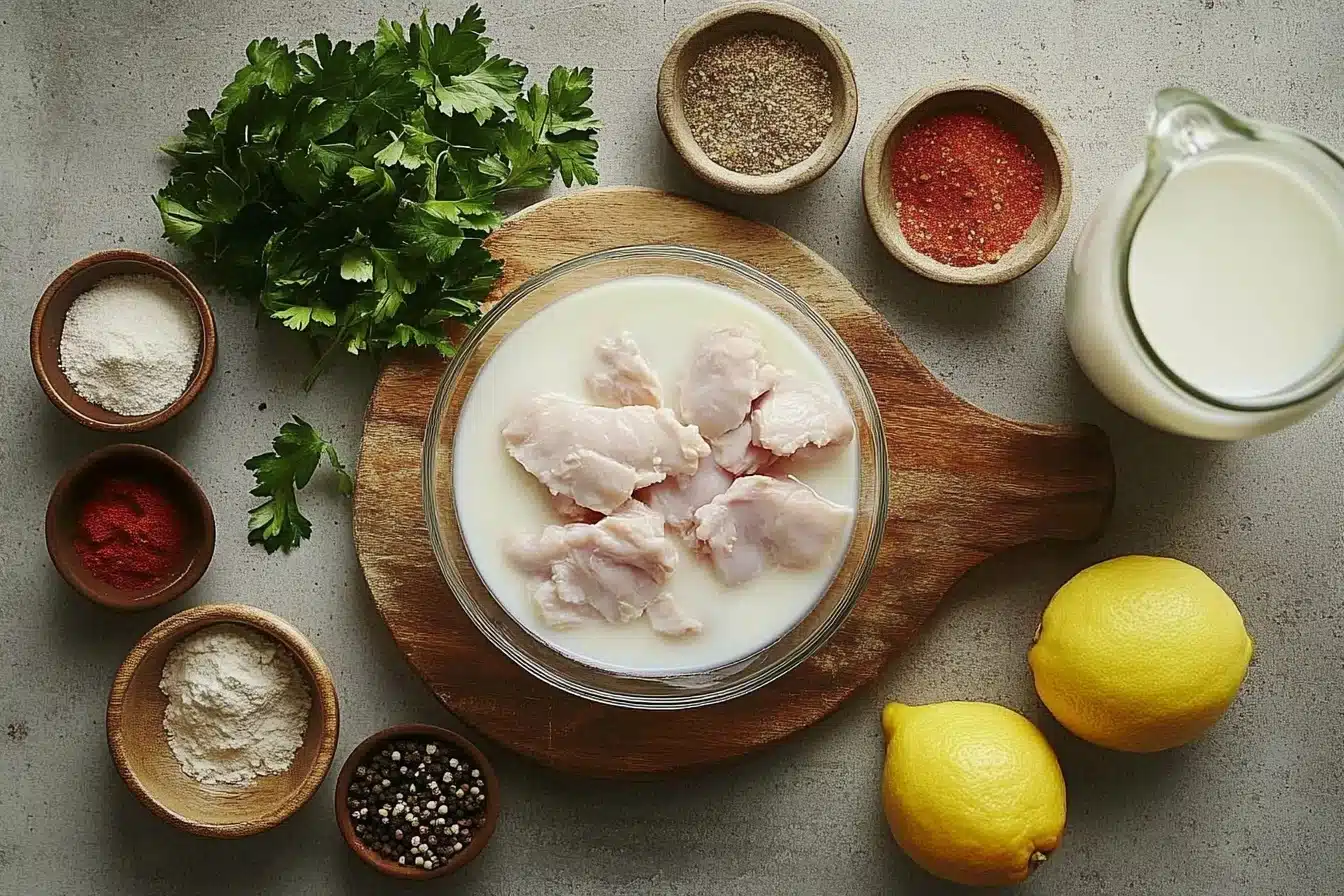Fried chicken is undeniably one of the most beloved dishes across the globe. Whether served crispy and golden at family dinners or as the main attraction during special occasions, everyone wants their fried chicken to taste perfect. Yet, not all fried chicken is created equal! Many chefs and home cooks swear by a little-known trick: soaking chicken in milk before frying. Why? The practice not only makes chicken incredibly tender but also helps develop rich, savory flavors.
In this guide, we’ll uncover the science behind this method, step-by-step instructions, and why milk has become a go-to marinating agent for fried chicken aficionados. Let’s dig in!
Overview of Fried Chicken Preparation
Before delving into the milk-soaking technique, it’s essential to understand the foundations of fried chicken preparation. The key to a good fried chicken recipe isn’t just about the frying process—it’s also about the pre-frying steps that determine the final taste and texture.
From the seasoning of the chicken to the coating and frying oil temperature, every detail matters. However, marination plays a pivotal role. Allowing the chicken to soak in flavorful liquids, such as milk, ensures that it absorbs the marinade deeply, leading to a juicier and more delicious bite.
Introduction to the Practice of Soaking Chicken in Milk
Soaking chicken in milk before frying is not just a culinary trend but a well-established technique used by home cooks and professional chefs alike. The method involves immersing raw chicken in milk or buttermilk for a set period before breading and frying. This step serves multiple purposes—it tenderizes the chicken, infuses it with subtle flavors, and ensures that the coating adheres perfectly to the meat.
Why milk, though? Milk contains enzymes and lactic acid, which work together to soften proteins in the chicken. Additionally, its neutral flavor doesn’t overpower the chicken, allowing other spices and seasonings to shine.
If you’re looking for a step-by-step guide to mastering the art of pan-frying chicken and achieving crispy perfection every time, check out The Ultimate Guide to Pan-Fried Chicken. This resource dives deeper into tips and techniques for perfecting your pan-frying skills.
Historical Context of Marinating Chicken
Traditional Marination Techniques Across Cultures
Marinating chicken isn’t a new concept. Across the world, different cultures have developed unique methods to tenderize and flavor their poultry. In South Asia, yogurt-based marinades enriched with spices are a staple, while in the Caribbean, citrus juices are used to add a tangy zest. Each technique focuses on balancing tenderness and flavor.
Historically, marinades have relied on acidic or enzymatic components, such as lemon juice, vinegar, or papaya, to break down proteins in the meat. These methods ensure the chicken is moist and packed with flavor once cooked. However, dairy-based marinades, particularly milk, stand out due to their dual tenderizing and mild flavor-enhancing qualities.
Emergence of Milk as a Marinating Agent
The use of milk in marination likely began out of necessity in agricultural societies. Fresh milk was readily available, and cooks discovered its ability to tenderize tougher cuts of meat. Over time, milk became more than a tenderizer—it was recognized for its capacity to neutralize gamey flavors and add subtle richness to the meat.
Interestingly, milk-based marinades aren’t exclusive to chicken. Other meats, such as pork and lamb, have also benefited from milk soaking. The versatility of milk in cooking highlights its unique properties as a gentle yet effective marinating agent.
The Science Behind Soaking Chicken in Milk
Role of Lactic Acid in Tenderizing Meat
The tenderizing magic of milk lies in its lactic acid content. This natural compound is mild yet powerful enough to break down the muscle fibers in chicken, resulting in softer, juicier meat. Unlike harsher acidic marinades like vinegar or citrus juice, lactic acid works gently, ensuring that the chicken retains its structure without becoming mushy.
Furthermore, lactic acid doesn’t just tenderize—it also helps balance flavors. By reducing the strong, sometimes gamey taste of chicken, it makes the meat more appealing to a wider range of palates. Whether you’re preparing fried chicken for a family meal or a dinner party, this subtle enhancement can make all the difference.
Interaction Between Milk Enzymes and Chicken Proteins
Beyond lactic acid, milk contains natural enzymes that interact with the proteins in chicken. These enzymes, such as protease, work to break down tough protein structures, creating a more tender texture. The result is chicken that is easier to chew and incredibly moist after frying.
Additionally, milk acts as a mild brine, locking moisture into the chicken as it soaks. This ensures that when the chicken is fried, it doesn’t dry out, even if it spends a little extra time in the oil. The dual action of enzymes and moisture retention makes milk a standout choice for marinating chicken.
Benefits of Soaking Chicken in Milk Before Frying
Soaking chicken in milk before frying is more than just a culinary trick—it’s a method backed by science and experience. From improving texture to enhancing flavor, milk delivers a range of benefits that elevate fried chicken to the next level. Here’s a closer look at how this simple step makes a big difference.
Enhanced Tenderness and Juiciness
One of the most noticeable benefits of milk-soaked chicken is its tender, juicy texture. Milk contains lactic acid, which gently breaks down the proteins in chicken. This process softens the meat without turning it mushy, as harsher marinades sometimes do.
Moreover, milk’s natural fat content helps lock in moisture. As the chicken fries, this retained moisture ensures that the meat remains succulent on the inside, even as the outside develops its signature crispy crust. Whether you’re frying drumsticks or tenders, milk ensures that each bite is irresistibly tender.
Flavor Development and Reduction of Gamey Taste
Milk doesn’t just tenderize—it also enhances the flavor profile of fried chicken. Its mild, slightly sweet taste complements the spices and seasonings added during marination. Additionally, milk neutralizes any gamey or overpowering flavors in the chicken, creating a more balanced and universally appealing dish.
The milk proteins play a role here, binding with compounds in the chicken that can contribute to strong, unwanted flavors. This is especially helpful for older cuts of chicken or those sourced from free-range farms, which tend to have a more pronounced taste.
Improved Coating Adhesion During Frying
A successful fried chicken recipe depends on a perfectly crisp coating, and milk plays a key role in achieving this. When chicken is soaked in milk, its surface becomes slightly tacky, allowing flour or breadcrumbs to adhere better.
This enhanced adhesion ensures a consistent, even coating that doesn’t flake off during frying. Plus, milk helps the coating absorb some of its natural fats, resulting in a crust that’s golden, crispy, and full of flavor.
Comparative Analysis: Milk vs. Other Marinating Agents
Milk is a fantastic marinating agent, but how does it stack up against other popular choices like buttermilk, yogurt, or acidic marinades? Each has its strengths and ideal use cases. Let’s compare.
Buttermilk
Buttermilk, a tangy derivative of milk, shares many benefits with its parent ingredient. It contains lactic acid, which tenderizes chicken effectively. However, its higher acidity makes it more robust for tenderizing tougher cuts of chicken.
The slight tang of buttermilk also imparts a distinct flavor to fried chicken. Many Southern fried chicken recipes, for instance, rely on buttermilk for its rich, savory taste. If you prefer a stronger flavor profile, buttermilk might be the way to go.
Yogurt
Yogurt is another dairy-based marinade with excellent tenderizing properties. Its thick consistency coats chicken thoroughly, ensuring even marination. Like milk, yogurt contains enzymes and lactic acid, which soften meat over time.
However, yogurt is much tangier than milk, meaning it imparts a more pronounced flavor. This can work wonderfully in certain cuisines, such as Middle Eastern or Indian dishes, but might overpower the subtlety of traditional fried chicken.
Acidic Marinades (e.g., Lemon Juice, Vinegar)
Acidic marinades like lemon juice and vinegar are common alternatives to dairy-based ones. These liquids work quickly to break down proteins, making them ideal for short marination periods. However, their higher acidity levels can sometimes over-tenderize chicken, resulting in a mushy texture.
Additionally, acidic marinades have a sharp taste that might not suit every palate. While they can add brightness and zest to chicken, they lack the creamy richness that milk provides, making them less ideal for frying.
Step-by-Step Guide to Soaking Chicken in Milk
Soaking chicken in milk is a straightforward process, but getting the details right can make a big difference. By following these steps, you’ll ensure that your chicken is perfectly tender and packed with flavor. Let’s break it down step by step.
Selecting the Appropriate Type of Milk
Not all milk is created equal when it comes to marinating chicken. While regular whole milk is a classic choice, other dairy options can offer additional benefits. For example:
- Whole Milk: Contains enough fat to tenderize and add richness to the chicken.
- Buttermilk: Offers a tangy flavor with extra lactic acid for effective tenderizing.
- Low-Fat Milk: Works in a pinch but lacks the creaminess needed for optimal results.
- Non-Dairy Milk Alternatives: Almond or soy milk can be used if lactose is a concern, but these lack the proteins and enzymes of dairy milk.
Pro tip: For the best results, stick with dairy-based milk options for soaking chicken before frying.

Recommended Soaking Duration
Time is a crucial factor in milk marination. Too short, and the benefits won’t fully develop; too long, and the chicken might become overly tenderized. Here’s a simple guideline:
| Chicken Cut | Soaking Time |
|---|---|
| Chicken Breasts | 2–4 hours |
| Chicken Thighs | 4–6 hours |
| Drumsticks or Wings | 6–8 hours |
| Whole Chicken Pieces | 8–12 hours |
Soaking your chicken overnight in the refrigerator is ideal, especially for thicker cuts like thighs and drumsticks. Avoid soaking beyond 12 hours, as this can result in a texture that’s too soft.

Optimal Temperature and Storage Conditions
Maintaining proper storage conditions is crucial for food safety while soaking chicken in milk. Always refrigerate the chicken in a sealed container, and avoid leaving it at room temperature to prevent bacterial growth. For detailed food safety tips and best practices, refer to this guide on Healthline.
- Refrigerate Immediately: Place the bowl or container with the milk-soaked chicken in the refrigerator to keep it fresh. Never marinate chicken at room temperature.
- Use a Covered Container: Seal the container tightly with a lid or plastic wrap to prevent cross-contamination with other foods in your fridge.
- Temperature Range: Ensure the refrigerator is set between 35°F and 40°F (1.6°C to 4.4°C) for safe storage.
Important: If you’re in a hurry, you can soak smaller chicken cuts for 1–2 hours at a slightly cooler fridge temperature. However, this is less effective than long soaks.
Additional Ingredients to Enhance Flavor
While milk works well on its own, adding a few extra ingredients can elevate the flavor of your chicken. Here are some popular options to try:
| Ingredient | Effect on Flavor |
|---|---|
| Salt | Enhances overall taste and helps retain moisture. |
| Garlic (minced or powdered) | Adds a savory, aromatic depth. |
| Paprika or Cayenne | Introduces a subtle smokiness or spice kick. |
| Herbs (e.g., thyme, rosemary) | Brings a fresh, earthy flavor to the marinade. |
| Lemon Zest | Provides a touch of citrus brightness. |
Combine these ingredients with your milk marinade for a more dynamic flavor profile. Just ensure that you don’t overpower the chicken with too many strong spices if you want the milk’s subtle benefits to shine through.
Common Misconceptions About Soaking Chicken in Milk
The practice of soaking chicken in milk before frying has become increasingly popular, but like many culinary techniques, it’s surrounded by a few misconceptions. Let’s clear up some of the most common myths to ensure you get the best results when using this method.
Myth: Milk Soaking Makes Chicken Greasy
A common concern among skeptics is that soaking chicken in milk might make it greasy or overly rich. However, this is far from the truth. Milk’s role in marination is to tenderize and subtly flavor the chicken, not to add oiliness.
In fact, when the chicken is properly drained after soaking, any excess milk is removed before breading and frying. This step ensures that the milk’s natural fats don’t contribute to an unwanted greasy texture. Instead, they help the meat stay moist during cooking. The frying process itself will create a crispy exterior while sealing in the juicy, tender interior, leaving no trace of greasiness.
Myth: Any Type of Milk Yields the Same Results
Another misconception is that all types of milk work equally well for soaking chicken. While it’s true that you can marinate chicken in various milk options, the results can differ significantly depending on the type used.
- Whole Milk: Provides the ideal balance of fat and protein, making it the best choice for tenderizing and flavoring chicken.
- Buttermilk: A superior alternative for a slightly tangier flavor and more pronounced tenderizing effect.
- Low-Fat Milk: Can work in a pinch but lacks the richness needed for optimal marination.
- Non-Dairy Milks: While almond or soy milk might be suitable for those with dietary restrictions, they don’t contain the proteins and lactic acid found in dairy milk that contribute to tenderization.
Selecting the right type of milk is crucial for achieving the desired texture and taste. Stick to whole milk or buttermilk for the best results, especially when preparing fried chicken.
Expert Opinions on Milk-Marinated Fried Chicken
Milk-marinated fried chicken isn’t just a home cook’s trick—it’s a technique backed by professional chefs and culinary scientists alike. Their insights reveal why soak chicken in milk before frying is not only practical but also one of the best ways to prepare tender and flavorful fried chicken.
Insights from Professional Chefs
Many professional chefs swear by soaking chicken in milk before frying, citing its ability to tenderize meat while enhancing its natural flavors. According to some experts, why soak chicken in milk before frying works because milk acts as a mild and versatile base that complements a variety of seasonings and herbs. Chef-inspired recipes often call for buttermilk, a tangier option, which helps break down tougher proteins while creating a deeper flavor profile.
Chefs also appreciate how milk preps the chicken for frying. Milk-soaked chicken tends to develop a slightly sticky surface, which ensures that the breading adheres more evenly. This step not only improves the coating’s texture but also helps achieve a golden, crispy crust. The consistent success of why soak chicken in milk before frying has made it a staple in classic Southern fried chicken recipes.
Culinary Scientists’ Perspectives
Culinary scientists highlight the chemistry behind why soak chicken in milk before frying is so effective. The proteins in milk, such as casein and whey, bond with the chicken’s muscle fibers, which reduces toughness and helps retain moisture during frying. These proteins work alongside lactic acid, a natural compound in milk, which gently breaks down connective tissues without compromising the meat’s texture.
Moreover, scientists emphasize that milk’s neutral pH level makes it less likely to “over-marinate” the chicken, a common issue with highly acidic marinades like vinegar or lemon juice. This balance reinforces the idea of why soak chicken in milk before frying as an ideal method for ensuring consistent tenderness and flavor absorption. Whether guided by chefs or scientists, the benefits of soaking chicken in milk are undeniable, showing precisely why soak chicken in milk before frying continues to be a trusted technique.

Frequently Asked Questions (FAQs)
From marinating techniques to frying methods, questions about preparing chicken are common. Here are some of the most frequently asked questions to help you perfect your chicken dishes.
How to pan fry chicken sausage?
Pan-frying chicken sausage is quick and simple. Start by preheating a skillet over medium heat and adding a small amount of oil to prevent sticking. Place the sausages in the pan, ensuring they don’t touch to allow even cooking. Cook for about 10–12 minutes, turning occasionally to brown all sides. For thicker sausages, consider covering the pan for the last few minutes to ensure they cook through. Use a meat thermometer to confirm they’ve reached an internal temperature of 165°F (74°C).
For a detailed, step-by-step guide on preparing perfectly cooked chicken sausage, check out How to Pan Fry Chicken Sausage: A Step-by-Step Guide. This guide covers everything you need for a quick, delicious result.
How long to pan fry boneless chicken thighs?
Boneless chicken thighs typically require 6–8 minutes per side when pan-fried over medium heat. Start by heating oil in a skillet until it’s shimmering, then add the seasoned chicken thighs. Allow them to sear without moving to develop a golden crust, flipping only once to maintain moisture. Always check that the internal temperature reaches 165°F (74°C) before removing them from the heat. Rest the thighs for a few minutes before serving to lock in the juices. For a complete guide on cooking times and tips to ensure your chicken thighs are perfectly cooked, visit How Long to Pan Fry Boneless Chicken Thighs: Complete Guide. It’s a handy resource for achieving consistent and juicy results every time.
Is it better to pan fry chicken in butter or oil?
The choice between butter and oil depends on your preferences and the cooking method. Butter adds richness and flavor but has a low smoke point, which can lead to burning at higher temperatures. Oil, particularly neutral options like vegetable or canola oil, withstands higher heat, making it ideal for frying. A popular compromise is combining butter and oil to enjoy the flavor of butter without sacrificing the stability of oil during cooking. For a detailed comparison of butter and oil in pan-frying, including pros, cons, and cooking tips, visit Pan Frying Chicken: Butter or Oil – Which is Better?. It’s the perfect resource for making an informed choice.
Why should chicken be soaked in milk before frying?
Soaking chicken in milk before frying tenderizes the meat and adds subtle flavor. Milk contains enzymes and lactic acid, which break down tough muscle fibers, resulting in softer, juicier chicken. Additionally, milk neutralizes any gamey or strong flavors, making the chicken more palatable. This step also helps the breading adhere evenly, creating a crispy and flavorful crust during frying.
How long should chicken be soaked in milk before frying?
The ideal soaking time depends on the chicken cut. For smaller pieces like tenders, 2–4 hours is sufficient, while larger cuts like thighs or drumsticks benefit from 6–8 hours. Whole chicken parts may need up to 12 hours for the marinade to fully work its magic. Avoid exceeding 12 hours, as over-soaking can lead to an overly soft texture that compromises the meat’s integrity.
Conclusion
Recap of Key Points
Why soak chicken in milk before frying? The answer lies in the balance of science and simplicity. This proven method enhances tenderness, juiciness, and flavor while improving coating adhesion for a crispier crust. Soaking chicken in milk before frying works thanks to the natural enzymes and lactic acid in milk, which break down proteins and lock in moisture. Whether it’s tenders, thighs, or drumsticks, this approach ensures moist, flavorful chicken every time. The benefits of soaking chicken in milk before frying make it an indispensable step for the perfect fried chicken.
Final Thoughts on the Practice
When considering why soak chicken in milk before frying, it’s clear that this method delivers unparalleled results. Incorporating milk into your preparation process creates tender, juicy chicken that fries to perfection. With the right type of milk, a well-timed soak, and optional flavor-enhancing ingredients, this method can elevate any fried chicken recipe. Whether you’re a seasoned chef or a casual cook, understanding why soak chicken in milk before frying can make a world of difference in your kitchen.

